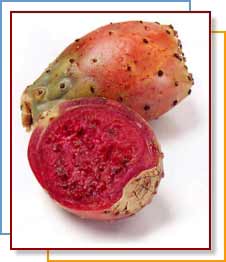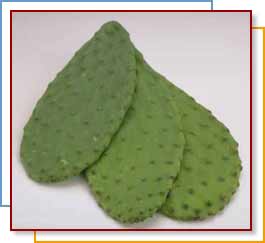
Edible cactus is also known as nopales (no-PAH-les), nopalitos or
cactus pads. This vegetable is popular in Mexico and other Central
American countries, parts of Europe, the Middle East, India, North Africa
and Australia. Its popularity is increasing in the United States where it
can be found at Mexican grocery stores, specialty produce markets and
farmer’s markets.
Edible cactus is characterized by its fleshy oval leaves (typically
called pads or paddles) of the nopal (prickly pear) cactus.
With a soft but crunchy texture that also becomes a bit sticky (not unlike
okra) when cooked, edible cactus tastes similar to a slightly tart green
bean, asparagus, or green pepper.
Cactus pads contain beta carotene, iron, some B vitamins, and are good
sources of both vitamin C and calcium.
| |
|
Cactus |
Serving Size
1/2 cup (43g)
| Amounts
Per Serving |
% Daily
Value |
| Calories 5 |
|
| Calories
from Fat 0 |
|
| Total Fat
0g |
0% |
| Sodium
10mg |
0% |
| Total
Carbohydrate 1g |
0% |
|
Dietary Fiber --g |
--% |
|
Sugars --g |
|
| Protein 1g |
|
| Vitamin A |
4% |
| Vitamin C |
6% |
| Calcium |
8% |
| Iron |
2% |
* Percent Daily Values are based on a
2,000 calorie diet. |
|
| |
|
Edible cactus is available year-round with a peak in the mid-spring and
the best season from early spring through late fall. When buying edible
cactus, choose small, firm, pale green cacti with no wrinkling. Be sure to
pick cacti that are not limp or dry. Very small paddles may require more
cleaning because their larger proportion of prickers and eyes.
Edible cactus can be refrigerated for more than a week if wrapped tightly in
plastic.
Edible cactus is also sold as:
- Canned — pickled or packed in water
- Acitrones — candied nopales, packed in sugar syrup and available in
cans or jars.
The edible cactus you buy should be de-spined though you will need to
trim the ‘eyes,’ to remove any remaining prickers, and outside edges of the
pads with a vegetable peeler. Trim off any dry or fibrous areas and rinse
thoroughly to remove any stray prickers and sticky fluid.
Edible cactus can be eaten raw or cooked. To cook, steam over boiling water
for just a few minutes (if cooked too long they will lose their crunchy
texture). Then slice and eat! Cactus can also be cut and sautèed in butter
or oil for a few minutes.
Steamed cactus can be added to scrambled eggs and omelets, or diced fresh
and added to tortillas. They can also be substituted for any cooked green in
most dishes.
The pads can be served as a side dish or cooled and used in salads. They
taste especially good with Mexican recipes that include tomatoes, hot
peppers and fresh corn.
 What is the difference between cactus leaves
(edible cactus or nopales) and the prickly pear? What is the difference between cactus leaves
(edible cactus or nopales) and the prickly pear? As part of the cactus plant, the prickly pear is a fruit that is 2 to
4 inches long and shaped like an avocado. Its skin is coarse and
thick, not unlike an avocados and it ranges in color from yellow or
orange to magenta or red. Tubercles with small prickly spines can be
found on the prickly pear’s skin. This fruit’s flesh, which ranges in
color also from yellow to dark red, is sweet and juicy with crunchy
seeds throughout.
The prickly pear can be diced like pineapple and used as a topping on
yogurt or cereal or blended into a smoothie.
Recipes
 Sautèed Nopales, Peppers and Corn Sautèed Nopales, Peppers and Corn
Makes 4 servings
Each serving equals 2 cups of fruit or vegetables
Ingredients
1 large red bell pepper
1 large green bell pepper
1 large onion
1 Tbsp trans-fat free butter
4 small ears of small summer corn
½ lb fresh, firm edible cactus, deprickered, cut in ¼ to ½-inch dice
finely minced cilantro or parsley
Halve peppers, then remove seeds and stems. Cut into ¼–½ inch squares.
Cut onions the same size. Cook both vegetables in butter in a heavy pan
over moderate heat until just softened.
Shuck corn, than cut from cob. Add edible cactus and corn to peppers and
onion; stir over high heat until vegetables are cooked through, but
firm-tender, about 5 minutes. Sprinkle with herbs and serve hot.
Nutritional analysis per serving: Calories 184, Protein 6g, Fat 4g,
Calories From Fat 20%, Cholesterol 8mg, Carbohydrates 32g, Fiber 4g,
Sodium 29mg.
Find more in our
recipe database!
|



